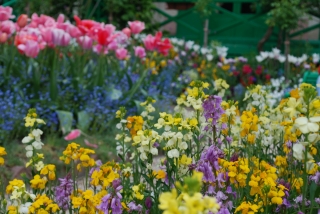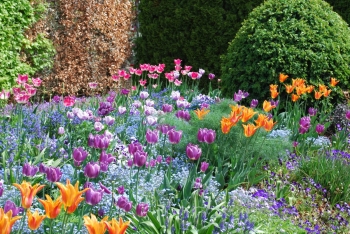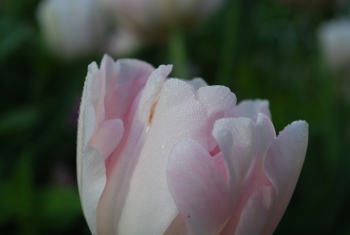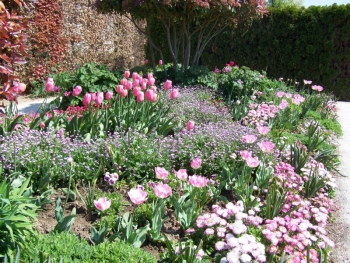April 28, 2017
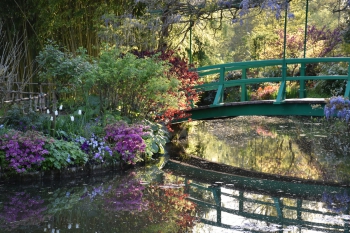
Spring makes us all want to walk in beautiful gardens. At Giverny, azaleas and tulips gradually give way to irises, peonies and wisterias. The first water lilies should open within two weeks, recreating once more Monet’s beautiful setting and endless source of inspiration. 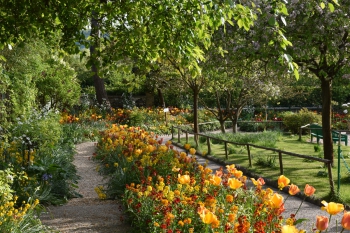
In the flower garden, visitors meander inside of a living painting where flowers recreate the illusion of brushstrokes. Monet had good reasons to claim that his garden was his most beautiful masterpiece.
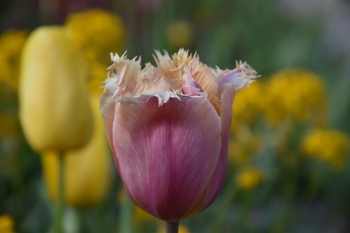
Just like you can see the brushwork when you tour an exhibition and have a close look at paintings, at Giverny each single flower is a little universe in itself, offering its beauties to our admiration.
Posted in Giverny, Monet's flower garden, Water-Garden, Flower 1 Comment »
April 30, 2016
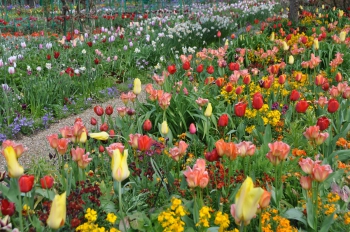
In late April, Monet’s flower garden at Giverny shimmers of the colors of thousands of tulips and other spring bulbs. Used like little dots of paint on a canvas, their planting is so subtle that it combines mass effect and delicacy.

The Grand Alley sports patches of fresh colors.
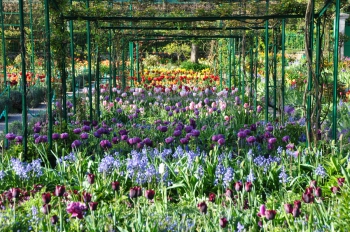
The ‘paint-box’ aligns little beds of pure colors side by side, like tubes of paint in an artist box. The result is a rainbow framed by the trellis.
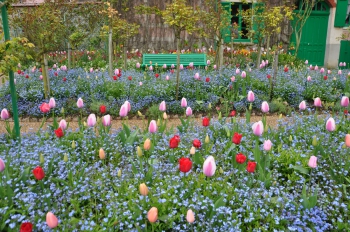
Delicate, dainty? Forget-me-not needs some popping red in order not to look twee.
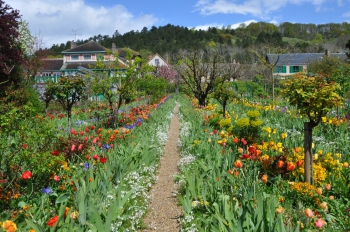
On the western side of the flower garden, rows of tulips recall the tulips fields in Holland that Monet loved and painted. The colors chosen for this side of the garden are those of sunset: yellow, orange and red.
Posted in Monet's flower garden 1 Comment »
April 11, 2015
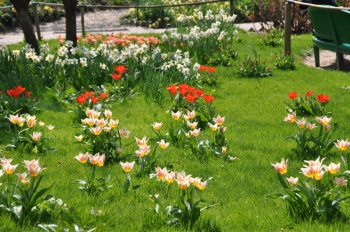
In April, as soon as the sun shines, Monet’s garden radiates. The colors are brighter than ever. Greens are vibrant. Red tulips flame in their complementary color. All the upside down bells of the bulb flowers resemble shiny laterns that have just been switched on.
What is the reason therefore? A freshly washed air, cool enough not to contain any haze? Or is it due to the height of the sun? I don’t know. But it is properly amazing and special to early spring. The glow of April makes you want to come out in the garden, to paint and to photograph.
Posted in Monet's flower garden No Comments »
November 23, 2012
While Giverny is closed for the winter, the gardeners of Fondation Monet are busier than ever. They are getting Monet’s gardens ready for next spring. After pulling out the annuals and cutting the perennials down to ground, they prepare the soil and start the planting. Thousands of bulbs must be planted as soon as possible, preferably before frost.
The beds in front of Monet’s home obey the same color schemes every year. Enormous tulips in different shades of pink combine with blue forget-me-not. The trick is to choose a palette of tones ranging from apricot to mauve to obtain an illusion of brushstrokes. The effect lasts longer than expected because early and late blooming tulips are used together. A row of dianthus surrounds the beds.
Next to these most impressive pink tulip beds, a border made with different kinds of yellow wallflowers offers a strong contrast in terms of color, size and shape. This border located under the pink blossom of three crab apple trees is partly shaded. Mauve blue bells scattered among the wall flowers produce an effect of shade and sunshine. The border is lined by white daisies. Last spring the gardeners added white tulips, for a very fresh result.
Posted in Monet's flower garden 3 Comments »
April 8, 2012
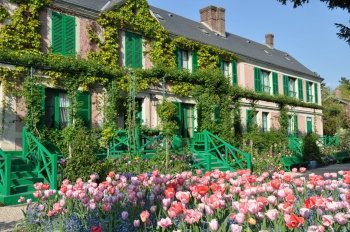 In April, the pink facade of Monet’s house in Giverny responds to huge beds of pink tulips in front of the main entrance.
In April, the pink facade of Monet’s house in Giverny responds to huge beds of pink tulips in front of the main entrance.
To create a shimmering effect, several varieties of pink tulips are planted, some redder, pinker or even orange, to resemble Monet’s brushstrokes on the canvas.
The pink tulips are underplanted by blue forget-me-not.
Posted in Monet's House No Comments »
March 12, 2011
 If you are planning a visit to Monet’s garden in Giverny, you may wonder what is the best time of year to come. There are many! The scenery, the flower show change with the seasons. One of my favorite time is the tulip’s.
If you are planning a visit to Monet’s garden in Giverny, you may wonder what is the best time of year to come. There are many! The scenery, the flower show change with the seasons. One of my favorite time is the tulip’s.
Tulips flower mostly during the second half of April. Their blooming is spectacular, gorgeous, breathtaking. They offer colors, colors, colors, always bright ones, they can have soft and tender or very warm flaming tones. They exist in an infinite variety of forms and aspects. And they provide amazing mass effects.
This border, for instance, was designed by Monet after visiting and painting the tulip fields in Holland. He was impressed by the large colorful stripes of these cultures.
When he came back to Giverny, Monet decided he wanted a very long border in his garden, from top to bottom, planted according to a monochromatic scheme.
This oversized flower bed records to his visual experience in Holland, as far as color and size are concerned. But Monet could not be satisfied with one sort of tulips only. His ‘tulip field’ is a very refined mixed border composed of many different sorts of tulips. They harmonize, their pink is slightly different, producing the subtle variation of tones that one can observe on an impressionist painting. A beautiful example of the way Monet used flowers like brushstrokes.
Posted in Monet's flower garden 2 Comments »
May 7, 2010
American visitors to Giverny often ask to which agricultural zone Giverny belongs. A puzzling question indeed, as these zones aren’t commonly used in France!
Asking about the coldest temperature in Winter doesn’t help a lot, because the Frenchs count in Celsius, not in Farenheit.
I finally found the answer: Giverny is in zone 8.
During the coldest night of the last Winter, temperatures reached -13°C, that is to say 8°F. This is OK for many plants, trees and bushes, except the most fragile.
Some flowers even need frost to understand that it is Winter, and then Spring. If tulips, for instance, don’t get all the cold they need, they will sulk and refuse to bloom the next Spring!
Posted in Flower, Impressionism Museum No Comments »
May 2, 2009
What would be Spring without tulips? They illuminate April in Monet’s garden at Giverny.
According to the head gardener, the list of the varieties displayed in the garden is very long: several hundreds of types of tulips make the Clos Normand sort of a flower show.
It is unbelievable how different the tulips can be. Their colors range from pure white to almost black red, from light pink to deep purple, from pale yellow to bright orange. They can be ridiculously tiny, or incredibly tall. Some are classically round shaped, other ones look like stars, or are as twisted as a flame. The parrot tulips seem tightly shut jaws.
But all of them have this silky quality of petals that reminds of the shine of skin, enhanced by dew in the morning sunshine.
Posted in Monet's flower garden, Flower No Comments »
March 2, 2009
This is how the garden of the Museum of Impressionisms Giverny looks like in April.
Small chambers of monochromatic beds are hidden behind tall hedges. Each one has a different atmosphere, creating a surprising effect for visitors who stroll along the central alley.
Tulips are a must in spring, of course. But they need to be planted together with smaller flowers at their feet for a greater impact.
Several varieties are suitable to cover the bare ground. Pansies exist in so many colors that it is possible to create infinite harmonies.
Daisies are also a simple solution. Their pink gives a fresh look to the flower bed.
But if you are as lazy as I am, you will certainly prefer forget-me-nots. They reseed on their own and offer a very tender and poetic cloud of tiny flowers for weeks.
They are generally blue, but can also be found in pink or white. In Monet’s garden they are widely used: blue forget-me-nots with pink tulips, white ones with white tulips or pink with pink tulips for a ton sur ton harmony.
Here in the Museum’s garden they are planted in a wave towered by a bunch of tulips: this way they give rhythm to the border.
Posted in Impressionism Museum No Comments »









